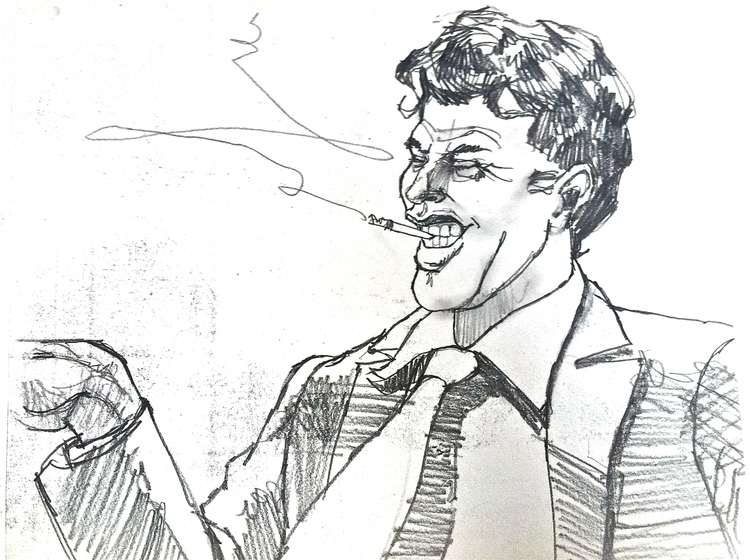Tom Waits For No One - the artists who made it happen
The story and the artists behind Tom Waits for No One is one of those rare events where talented young artists come together and create an iconic work that is ahead of the times, and is long gone when the times catch-up at last. Their humor, sense of style and fresh look at rotoscoped animation, using the latest technology, came through in the production studio and the drawings that seemed to grow organically on the walls. For most, this was their first job in animation.
When the production wrapped and it came time to clean-out the studio, all the "stuff" on the walls was saved. Even trashcans were gone through and the best drawings, doodles and sketches were rescued. Everything went into a scrapbook which now represents the complete story of Tom Waits For No One. The character development, the turn-arounds, the character riffs and personal interpretations provide a rare view into the mind of young animators breaking ground with the video rotoscope, animation's newest tool, never before used in production.
Now, 35 years on, this animated work inhabits a cross-roads in animation and technology history. The musician, Tom Waits, and many of the artists went on to successful careers, while the film itself became an urban legend of sorts - something very early Waits' fans saw once, but could never locate again.
If you've read "The Story", here's the backstory about the artists after their life with Tom Waits For No One:
Gary Beydler, a Los Angeles avant-garde film maker, completed his main body of work before 1977. Beydler's work is most often shown in experimental film classes, and is best known for "Pasadena Freeway Stills" (1974), "Hand Held Day" (1974) and "Venice Pier" (1977). In the 1990s, Beydler co-founded Animation Controls, a video animation system manufacturer, with John Lamb. In 2008, Beydler's films were restored by Mark Toscano and entered into Academy Film Archive's permanent collection. Beydler passed away in 2010 in Mission Viejo, California.
Mike Cressy moved into gaming and is now a senior game artist for Amazon Game Studio, as well as concept artist for Microsoft XBox Avatar Kinect. Cressy was also an illustrator, designer and animator at Electronic Arts, and continues his work as a teacher and guest speaker at art schools throughout the western U.S., with gallery openings at the Los Angeles chapter of Society of Illustrators.
Rod Dryden is a graduate of the Art Center College of Design in Pasadena and came to Lyon Lamb from Art Center's animation department. For the film, Rod was charged with applying the final character to the rotoscoped drawings. From the early character sketches, Rod’s art style heavily influenced the look of the Tom Waits character in TWFNO.
Donna Gordon is an actress, dancer and dance instructor who was introduced by Waits’ then agent as the dancer featured on ‘Small Change.’ Gordon also played Margo Donnar in John Casavetes’ The Killing of a Chinese Bookie.
John Lamb received an Academy Award for Scientific and Technical Achievement in 1980 for co-invention of the Lyon Lamb Video Animation System (VAS). Lamb also developed and manufactured the first video rotoscope system in 1979. In the 1980s, Lamb co-founded Animation Controls with Gary Beydler, while continuing to work in graphic arts and animation-related fields over the last three decades. Lamb recently opened his first solo art project "Blast from the Past" at LinkSoul Lab in Oceanside, CA.
Keith Newton, at 19 years old, was the youngest member of the animation team. Hired on the spot when John Lamb saw his portfolio, Newton relocated to Los Angeles from Detroit, Michigan to work on the film. Among all the incredible character studies completed in pre-production, Newton's character of Waits was chosen for the film, and Newton would do much of the rotoscoping himself. After Tom Waits For No One, Keith became a character designer for Disney, a background artist on Pocahontas, and now teaches at the College for Creative Arts in Detroit.
Ray Roberts graduated from Art Center College of Design in Pasadena and worked as an illustrator, opening studios in Los Angeles, California and Scottsdale, Arizona. With many solo shows throughout the United States, Roberts is now a renowned Plein Air painter and multiple award winner for his depictions of the Southwest.
Harry Sabin was a student at California Institute of the Arts when he started work on Tom Waits For No One. Sabin would go on to work on animated shorts for Warner Bros., and also worked in feature films like Osmosis Jones and The Iron Giant. Most recently, Sabin has worked in TV animation with The LIfe and Times of Juniper Lee and American Dad.
For David Silverman, Tom Waits For No One was his first job in animation. He would soon become the first Simpsons animator on the Tracey Ullman Show, and later director of The Simpsons Movie. Silverman was co-director of Monsters Inc. and was a 2012 Academy Award nominee, Best Animated Short Film, for The Longest Daycare featuring Maggie Simpson.
Garrett Smith served as vice president, production technology and digital mastering operations at Paramount Pictures. He was actively involved in the development of DVD, HDTV and a member of Digital Cinema Initiatives. Today, Smith is a member of the Academy of Motion Picture Arts and Sciences, and serves on the Science and Technology Council as Co-Chair of the Next Generation Technology Project.
